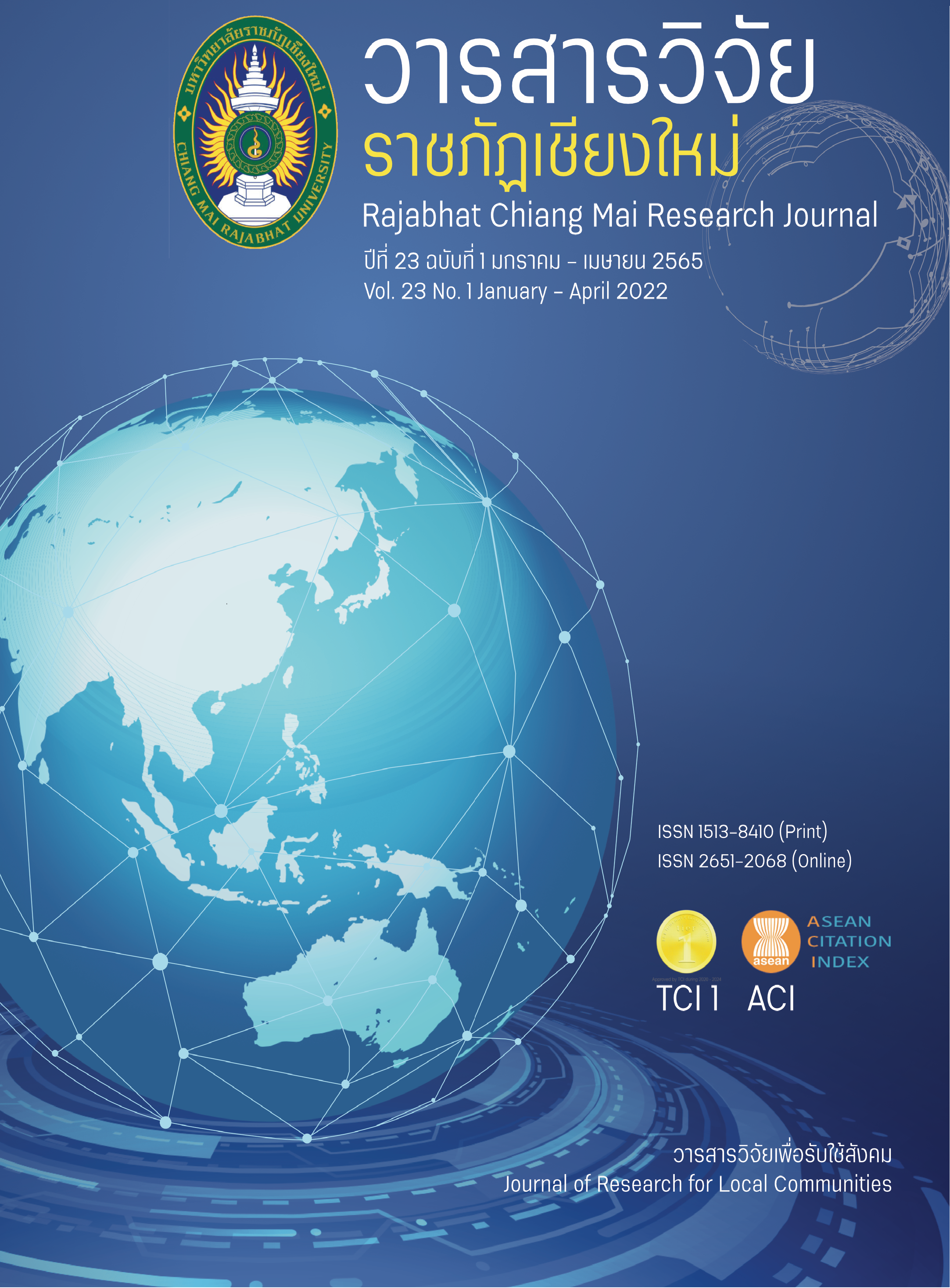Mae Chaem Woven Textile: Intangible Cultural Heritage and Knowledge Management toward Thai as a Foreign Language in Active Learning Concept
DOI:
https://doi.org/10.14456/rcmrj.2022.251807Keywords:
Intangible cultural heritage, Mae chaem woven textile, Thai as a foreign language, Active learning conceptAbstract
This article aims at analyzing and synthetizing a body of knowledge toward Mae Chaem Woven Textile as an intangible heritage for Thai language teaching design, as a foreign language for Chinese students, due to the active learning concept. As for this qualitative research, sources of study have been gathered by examining relevant documents along with participant observation and interviewed 15 informants about Tin Chok Mae Chaem in field study, then all have been analyzed, synthetized by content analysis and applied for knowledge management design. The research tools consisted of an interview form, a record form, an analysis and a synthesis of data and the research target group is 4th year Chinese learners in a university located in Chiang Mai. According to the study revelation, the body of knowledge toward Mae Chaem Woven Textile links with history, significant persons, garments and ornaments, tradition and belief, religious architecture, ethnicity, language, place, utensils and environment and nature. After being synthetized, it can be divided into five lessons: Chiangmai cultural tourism spots, history of Mae Chaem Woven Textile, relation between the textile and significant persons, ways of life and relevant belief and woven processes. The study result is adapted for design a knowledge management toward Thai as a foreign language for Chinese students due to the active learning concept with 5 lessons and 15 proactive learning management styles used. The in-class knowledge is linked with the out-class experience, which is a method of active learning for students’ participant motivation by self-experience and actual practice. Local wisdom, too, are applied in the learning process for increasing the students’ knowledge and Thai language skill as well as taking part in Thai local wisdom preservation and continuation.
Downloads
References
Blount, N.S. & Klausmeir, H. J. (1968). Teaching in secondary School. New York: Harper & Rowe.
Brown, H. Douglas. (2007). Principles of Language Teaching and Learning. Fifth edition. New York: Addison Wesley Longman, Inc.
Cheauthai, J. (2014). Mae Chaem Woven Textile: Present from the Past Ways of Life, Belief, Art and Culture. Advanced Thailand Geographic Journal, 19(14), 162-179 (In Thai)
Chumphengphan, P. (2001). Chinese Auspicious Animals. Bangkok: Business Organization of Teachers' Council. (In Thai)
Dejagupt, P., & Yindeesuk, P. (2018). Active Learning with PLC for Development. Bangkok: Chulalongkorn University Printing House. (In Thai)
Department of Intellectual Property. (2003). Geographical Indication Act. Retrieved from http://www.ipthailand.go.th/th/dip-law-2/item/พระราชบัญญัติคุ้มครองสิ่งบ่งชี้ทางภูมิศาสตร์%20 พ.ศ.%202546.html (In Thai)
Department of Intellectual Property. (2007). Announcement of Department of Intellectual Property on Geographical Indication Registration: Mae Chaem Woven Textile Registration No. สช 50100015. Retrieved from http://www.ipthailand.go.th/th/gi-011/item/15-สช-50100015-ผ้าตีนจกแม่แจ่ม-2.html. (In Thai)
Department of Religious Affairs, Ministry of Education. (1990). History of Temples throughout the Kingdom, Vol. 9. Bangkok: Printing House. Religion. (In Thai)
Faculty of Arts, Chulalongkorn University. (1992). Tai-Kadai: Garments and Ornaments of female in Tai Dam- Dòng-Li Tribes. Bangkok: Department of Research Affairs, Chulalongkorn University. (In Thai)
Inphoo, P., & Nomnian, S. (2019, January-June). Dramatizing a Northeastern Thai Folklore to Lessen High School Students, Communication Anxiety. PASAA, 57, 33-66. (In Thai)
Li, H. Y. (2016, June). Legend of Lei Zu, the Silk Discovery. Confucius Institute, (37), 74-75.
Ministry of Culture. (2009). Intangible Cultural Heritage. Bangkok: Office of the National Culture Commission. (In Thai)
Phakdinarong, P. (2005). Politics and Aesthetics of Mae Chaem Woven Textile in Song, Music, Riddle, Textile: local Wisdom of Recreation and Craftsmanship. Bangkok: Princess Maha Chakri Sirindhorn Anthropology Centre (Public Organization). (In Thai)
Prangwatthanakul, S. (1990). Lanna fabrics Yuan Lue Laos (3rd ed.). Bangkok: Amarin Printing Group Co., Ltd. (In Thai)
Prince, M. (2004, July). Does active learning work?. A review of the research. Journal of Engineering Education, 93(3), 223-231.
Qin, R. (2016). Auspicious Animals and Brids in Chinese Culture. Shi Dai Chuan Mei You Xian Gong Si: Huang Shan Shu She.
Rowntree, D. (1981). A dictionary of education. London: Harper & Row.
Rungrueangsri, U. (1999). Dararasmi, Princess of Consort. In Encyclopedia of Thai Culture: the Northern Part Vol.5. Bangkok: Thai Cultural Encyclopedia Foundation. (In Thai)
Somwatha, F., Khonjaibun, A., & Thakham, K. (2006). History of Tin Chok and Fabric of Maejam. (Research report., RDG47N0020., The Thailand Research Fund.). (In Thai)
Thikhachunhathien, R. (2006). Thai dialects. Chiang Mai: Department of Thai Language Faculty of Humanities Chiang Mai University. (In Thai)
Watcharadumrong, P., Kantang, I., Chansuebsri, S., Suphasri, J., Sawngiw, S., Chanphrom, P., Khamphangkaew, N. (2018). Area-based Development Project through Art and Culture Resources of Mae Chame District, Chang Mai Province. (Research report., RDG59A0025., The Thailand Research Fund.). (In Thai)
Downloads
Published
How to Cite
Issue
Section
License
Copyright (c) 2022 Rajabhat Chiang Mai Research Journal

This work is licensed under a Creative Commons Attribution-NonCommercial-NoDerivatives 4.0 International License.
1. Articles, information, content, images, etc published in the “Community and Social Development Journal” are copyrighted by the Community and Social Development Journal, Chiang Mai Rajabhat University. In order to properly distribute the articles through print and electronic media, the authors still hold the copyright for the published articles under the Creative Commons Attribution (CC BY) license, which allows the re-distribution of the articles in other sources. References must be made to the articles in the journal. The authors are responsible for requesting permission to reproduce copyrighted content from other sources.
2. The content of the articles appearing in the journal is the direct responsibility of the article authors. The editorial board of the journal does not necessarily agree with or share any responsibility.














